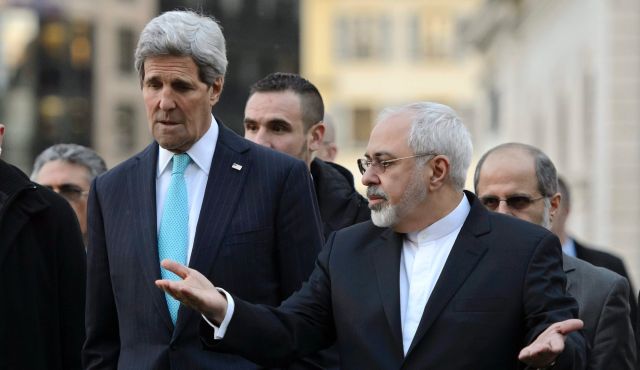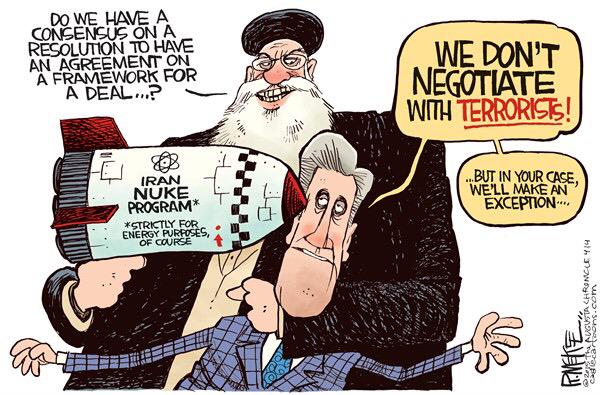PHOTO: US Secretary of State John Kerry and Iranian Foreign Minister Mohammad Javad Zarif, January 14, 2015
TUESDAY FEATURE
Audio Analysis: Imminent Deal? Reality and Spin of the Nuclear Talks
Analysis: How a Nuclear Deal Helps Democracy in the Islamic Republic
UPDATE 1715 GMT: Iran and the 5+1 Powers have formally agreed to extend the June 30 deadline by a week to pursue completion of the comprehensive agreement.
In a sign of progress, unnamed diplomats said Iran had moved towards satisfaction of the 5+1’s demand that the in-country stock of low-enriched uranium is an acceptable level, far removed from potential development for a military program.
Under the interim agreement of November 2013, Iran agreed to cap its stockpile of 5% uranium at a little more than 7.6 tons, while transformed all 20% stock into oxide powder or fuel plates to render military use difficult or impossible.
Iran was supposed to be under the cap for 5% uranium by today, but in May, the International Atomic Energy Agency said the stockpile was more than 8 tons.
The diplomats said Tehran is now under 7.6 tons, with public confirmation on Wednesday in a new report by the IAEA.
UPDATE 0915 GMT: As his Foreign Minister returns to nuclear talks, the Supreme Leader gives a high-profile endorsement of Mohammad Javad Zarif and Iran’s team in Vienna:
I recognize our negotiators as trustworthy, committed, brave and faithful.
#IranTalks
https://t.co/gj5IMikjL7 pic.twitter.com/MTCWJi41K0
— Khamenei.ir (@khamenei_ir) June 30, 2015
Foreign Ministers are scheduled to return to nuclear talks between Iran and the 5+1 Powers on Tuesday, the formal deadline for a comprehensive agreement.
The Ministers adjourned weekend discussions on Sunday night in Vienna, with Iran’s Mohammad Javad Zarif returning to Tehran for consultations and US Secretary of State John Kerry remaining in Europe. The British, French, and German Foreign Ministers were also involved in discussions, with China and Russia represented by Deputy Foreign Ministers.
There is no chance of a deal today. Instead, both Iran and the 5+1 (US, Britain, France, Russia, and China) have agreed on an extension of a “few days” for completion.
Meanwhile, the US delegation is maintaining a firm public line that Iran must take final steps to meet conditions over their nuclear facilities, uranium enrichment, and inspections.
A “senior United States official”, briefing journalists on Monday, said Tehran must stick to the American interpretation of an April 2 nuclear framework agreed in Switzerland:
We do see a path forward to get a comprehensive agreement that meets our bottom lines. This path forward has to be based on the Lausanne parameters. Period.
An aide then repeated the message in Farsi.
However, the official put out one signal of a possible advance, with a compromise over the inspection of Iran’s military sites — some, but not all, facilities will be visited by the International Atomic Energy Agency:
We have worked out a process that we believe will ensure that the IAEA has the access it needs.
The entry point isn’t we must be able to get into every military site, because the United States of America wouldn’t allow anybody to get into every military site, so that’s not appropriate.
Iran has publicly maintained that there can be no inspections or questioning of nuclear scientists. But earlier this month, Russian Foreign Minister Sergei Lavrov indicated that a compromise was being arranged.
See Iran Daily, June 3: Russia’s Lavrov Points to Compromise in Nuclear Talks Over Military Sites
Iranian State media offers no further clues this morning, presenting matter-of-fact declarations that political deputies and technical teams continued discussion of the final text on Monday.
Press TV reports that Deputy Foreign Ministers Abbas Araqchi and Majid Takht-e Ravanchi held a three-hour meeting with European Union deputy foreign policy chief Helga Schmid. The Iranian negotiators also discussed the draft US Undersecretary of State Wendy Sherman.
However, the most optimistic assessment over the weekend came from the Iranian side, with an unnamed source offering details on the three stages of the agreement — linking the removal of sanctions to Iran’s compliance over nuclear facilities — to pro-deal activist Trita Parsi.
The initial phase, called “adoption of agreement”, takes place as the two sides agree on a final deal. This phase will kick in in the next few days — if a deal is reached.
The next phase, the operationalization of the agreement, will begin once the domestic political processes of various parties have conclusively approved the agreement. This phase has been added primarily as a result of the US Congress passing the Corker bill, in which the American legislature gave itself the right to review and vote on the nuclear deal.
The timing of the second phase is directly related to the duration of the Congressional review process. If the two sides come to an agreement prior to July 10, the review process is set at 30 calendar days, in addition to 22 calendar days for Congress to pass a resolution to accept or reject the deal and for the President to use his veto, if need be. If the two sides fail to reach a deal by July 10, the Congressional review process increases to 60 calendar days….
Once the deal has survived the Congressional review — whether through a resolution of affirmation or the failure to pass a resolution of rejection — the Iranians will begin implementing the first steps of their commitments after the US side has provided iron-clad guarantees that sanctions will be lifted. This is Phase III.
The initiation of the implementation of their end of the deal must then be verified by the IAEA [International Atomic Energy Agency], after which the US and its allies will begin relieving sanctions. It is at this point that the deal will be “signed,” enabling the Iranian demand for sanctions relief to occur upon signing of the deal to be upheld.
The exact timing of this schedule depends on the date the deal is adopted, the duration of the Congressional review and the time it takes for Iran to implement the first steps of the agreement. But at best it will begin a few months after the adoption of the deal. This is reflected by President Hassan Rouhani’s statement earlier in June that he expected relief from sanctions within a “couple of months” after an agreement is reached.
Meanwhile, as American and European diplomats play the card that the Supreme Leader “has been attempting to backtrack on some crucial elements of the April agreement”, those opposed to a deal in the US are far less subtle in their proclamations:
(Augusta Chronicle/Rick McKee)


